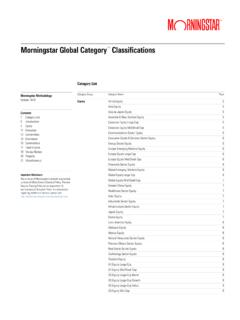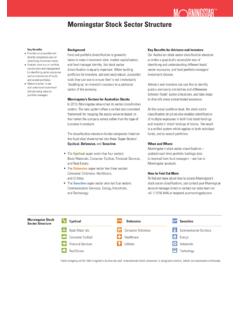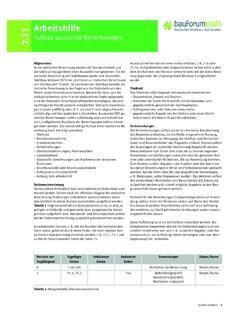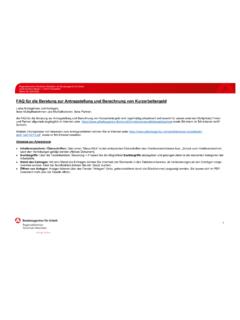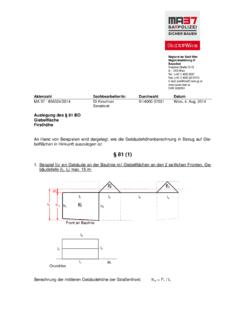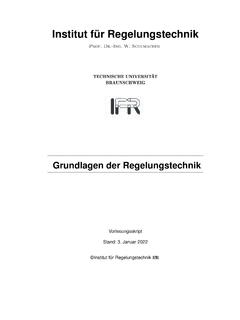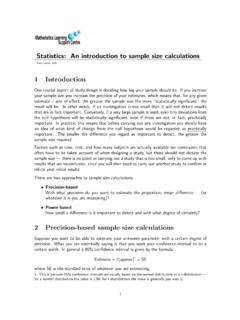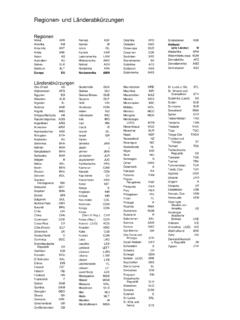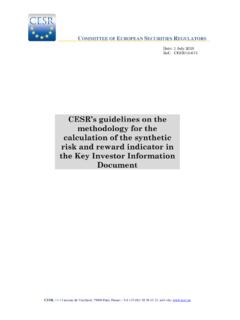Transcription of The Morningstar RatingTM for Funds
1 The Morningstar Rating for Funds TM. Morningstar Methodology Introduction August 2021. This document describes the rationale for, and the formulas and procedures used in, calculating the Morningstar Rating for Funds (commonly called the star rating ). This methodology applies to Contents Funds receiving a star rating from Morningstar , except in Japan where these are the Ibbotson Stars. 1 Introduction 2 Morningstar Categories 4 Theory The Morningstar Rating has the following key characteristics: 8 Calculations 3 The peer group for each fund's rating is its Morningstar Category . 12 The Morningstar Rating: Three-, Five-, and 10-Year 3 Ratings are based on Funds ' risk-adjusted returns.
2 13 Morningstar Return and Morningstar Risk Rating Morningstar Category 15 The Overall Morningstar Rating 16 Rating Suspensions The original Morningstar Rating was introduced in 1985 and was often used to help investors and 17 Conclusion advisors choose one or a few Funds from among the many available within broadly defined asset 18 Appendix 1: Risk-Free Rates Applied classes. Over time, though, increasing emphasis had been placed on the importance of Funds as 19 Appendix 2: Methodology Changes portfolio components rather than stand-alone investments. In this context, it was important that 20 Appendix 3: Star Ratings for Separately Managed Accounts and Models Funds within a particular rating group be valid substitutes for one another in the construction of a diversified portfolio.
3 For this reason, Morningstar now assigns ratings based on comparisons of all Important Disclosure Funds within a specific Morningstar Category, rather than all Funds in a broad asset class. Merged with the existing star rating The conduct of Morningstar 's analysts is governed by Code of Ethics/Code of Conduct Policy, Personal Risk-Adjusted Return Security Trading Policy (or an equivalent of), and Investment Research Policy. For information The star rating is based on risk-adjusted performance. However, different aspects of portfolio theory regarding conflicts of interest, please visit: http:// suggest various interpretations of the phrase risk-adjusted.
4 As the term is most commonly used, to risk adjust the returns of two Funds means to equalize their risk levels before comparing them. The Sharpe ratio is consistent with this interpretation of risk-adjusted.. But the Sharpe ratio does not always produce intuitive results. If two Funds have equal positive average excess returns, the one that has experienced lower return volatility receives a higher Sharpe ratio score. However, if the average excess returns are equal and negative, the fund with higher volatility receives the higher score because it experienced fewer losses per unit of risk. While this result is consistent with portfolio theory, many retail investors find it counterintuitive.
5 Unless advised appropriately, they may be reluctant to accept a fund rating based on the Sharpe ratio, or similar measures, in periods when the majority of the Funds have negative excess returns. Standard deviation is another common measure of risk, but it is not always a good measure of fund volatility or consistent with investor preferences. First, any risk-adjusted return measure that is based on standard deviation assumes that the riskiness of a fund's excess returns is well Page 2 of 21 The Morningstar RatingTM for Funds August 2021. 3 captured by standard deviation, as would be the case if excess return were normally or lognormally 3 distributed, which is not always the case.
6 Also, standard deviation measures variation both above 3 and below the mean equally. But investors are generally risk-averse and dislike downside variation more than upside variation. Morningstar gives more weight to downside variation when calculating Morningstar Risk-Adjusted Return and does not make any assumptions about the distribution of excess returns. The other commonly accepted meaning of risk-adjusted is based on assumed investor preferences. Under this approach, higher return is good and higher risk is bad under all circumstances, without regard to how these two outcomes are combined.
7 Hence, when grading Funds , return should be rewarded and risk penalized in all cases. The Morningstar Risk-Adjusted Return measure described in this document has this property. This document discusses the Morningstar Category as the basis for the rating, and it describes the methodology for calculating risk-adjusted return and the Morningstar Rating. Morningstar calculates ratings at the end of each month. Morningstar Categories Category Peer Groups Morningstar uses the Morningstar Category as the primary peer group for a number of calculations, including percentile ranks, fund-versus-category-average comparisons, and the Morningstar Rating.
8 The Morningstar Rating compares Funds ' risk-adjusted historical returns. Its usefulness depends, in part, on which Funds are compared with others. It can be assumed that the returns of major asset classes (domestic equities, foreign equities, domestic bonds, and so on) will, over lengthy periods of time, be commensurate with their risk. However, asset class relative returns may not reflect relative risk over ordinary investor time horizons. For instance, in a declining interest-rate environment, investment-grade bond returns can exceed equity returns despite the higher long-term risk of equities; such a situation might continue for months or even years.
9 Under these circumstances many bond Funds outperform equity Funds for reasons unrelated to the skills of the fund managers. A general principle that applies to the calculation of fund star ratings follows from this fact; that is, the relative star ratings of two Funds should be affected more by manager skill than by market circumstances or events that lie beyond the fund managers' control. Another general principle is that peer groups should reflect the investment opportunities for investors. So, categories are defined and Funds are rated within each of the major markets around the world. Morningstar supports different category schemes for different markets based on the investment needs and perspectives of local investors.
10 For example, Morningstar rates high-yield 2021 Morningstar , Inc. All rights reserved. The information in this document is the property of Morningstar , Inc. Reproduction or transcription by any means, in whole or in part, without the prior written consent of Morningstar , Inc., is prohibited. Page 3 of 21 The Morningstar RatingTM for Funds August 2021. 3 bond Funds domiciled in Europe against other European high-yield bond Funds . For more information 3 about available categories, please contact your local Morningstar office. 3. Style Profiles A style profile may be considered a summary of a fund's risk-factor exposures.

